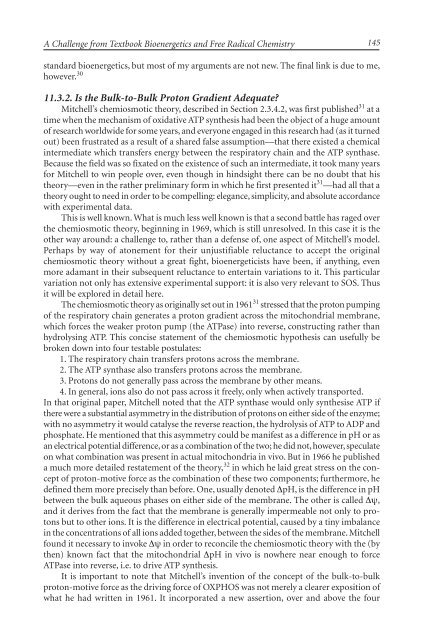The Mitochondrial Free Radical Theory of Aging - Supernova: Pliki
The Mitochondrial Free Radical Theory of Aging - Supernova: Pliki
The Mitochondrial Free Radical Theory of Aging - Supernova: Pliki
You also want an ePaper? Increase the reach of your titles
YUMPU automatically turns print PDFs into web optimized ePapers that Google loves.
A Challenge from Textbook Bioenergetics and <strong>Free</strong> <strong>Radical</strong> Chemistry<br />
standard bioenergetics, but most <strong>of</strong> my arguments are not new. <strong>The</strong> final link is due to me,<br />
however. 30<br />
11.3.2. Is the Bulk-to-Bulk Proton Gradient Adequate?<br />
Mitchell’s chemiosmotic theory, described in Section 2.3.4.2, was first published 31 at a<br />
time when the mechanism <strong>of</strong> oxidative ATP synthesis had been the object <strong>of</strong> a huge amount<br />
<strong>of</strong> research worldwide for some years, and everyone engaged in this research had (as it turned<br />
out) been frustrated as a result <strong>of</strong> a shared false assumption—that there existed a chemical<br />
intermediate which transfers energy between the respiratory chain and the ATP synthase.<br />
Because the field was so fixated on the existence <strong>of</strong> such an intermediate, it took many years<br />
for Mitchell to win people over, even though in hindsight there can be no doubt that his<br />
theory—even in the rather preliminary form in which he first presented it 31 —had all that a<br />
theory ought to need in order to be compelling: elegance, simplicity, and absolute accordance<br />
with experimental data.<br />
This is well known. What is much less well known is that a second battle has raged over<br />
the chemiosmotic theory, beginning in 1969, which is still unresolved. In this case it is the<br />
other way around: a challenge to, rather than a defense <strong>of</strong>, one aspect <strong>of</strong> Mitchell’s model.<br />
Perhaps by way <strong>of</strong> atonement for their unjustifiable reluctance to accept the original<br />
chemiosmotic theory without a great fight, bioenergeticists have been, if anything, even<br />
more adamant in their subsequent reluctance to entertain variations to it. This particular<br />
variation not only has extensive experimental support: it is also very relevant to SOS. Thus<br />
it will be explored in detail here.<br />
<strong>The</strong> chemiosmotic theory as originally set out in 1961 31 stressed that the proton pumping<br />
<strong>of</strong> the respiratory chain generates a proton gradient across the mitochondrial membrane,<br />
which forces the weaker proton pump (the ATPase) into reverse, constructing rather than<br />
hydrolysing ATP. This concise statement <strong>of</strong> the chemiosmotic hypothesis can usefully be<br />
broken down into four testable postulates:<br />
1. <strong>The</strong> respiratory chain transfers protons across the membrane.<br />
2. <strong>The</strong> ATP synthase also transfers protons across the membrane.<br />
3. Protons do not generally pass across the membrane by other means.<br />
4. In general, ions also do not pass across it freely, only when actively transported.<br />
In that original paper, Mitchell noted that the ATP synthase would only synthesise ATP if<br />
there were a substantial asymmetry in the distribution <strong>of</strong> protons on either side <strong>of</strong> the enzyme;<br />
with no asymmetry it would catalyse the reverse reaction, the hydrolysis <strong>of</strong> ATP to ADP and<br />
phosphate. He mentioned that this asymmetry could be manifest as a difference in pH or as<br />
an electrical potential difference, or as a combination <strong>of</strong> the two; he did not, however, speculate<br />
on what combination was present in actual mitochondria in vivo. But in 1966 he published<br />
a much more detailed restatement <strong>of</strong> the theory, 32 in which he laid great stress on the concept<br />
<strong>of</strong> proton-motive force as the combination <strong>of</strong> these two components; furthermore, he<br />
defined them more precisely than before. One, usually denoted ΔpH, is the difference in pH<br />
between the bulk aqueous phases on either side <strong>of</strong> the membrane. <strong>The</strong> other is called Δψ,<br />
and it derives from the fact that the membrane is generally impermeable not only to protons<br />
but to other ions. It is the difference in electrical potential, caused by a tiny imbalance<br />
in the concentrations <strong>of</strong> all ions added together, between the sides <strong>of</strong> the membrane. Mitchell<br />
found it necessary to invoke Δψ in order to reconcile the chemiosmotic theory with the (by<br />
then) known fact that the mitochondrial ΔpH in vivo is nowhere near enough to force<br />
ATPase into reverse, i.e. to drive ATP synthesis.<br />
It is important to note that Mitchell’s invention <strong>of</strong> the concept <strong>of</strong> the bulk-to-bulk<br />
proton-motive force as the driving force <strong>of</strong> OXPHOS was not merely a clearer exposition <strong>of</strong><br />
what he had written in 1961. It incorporated a new assertion, over and above the four<br />
145


